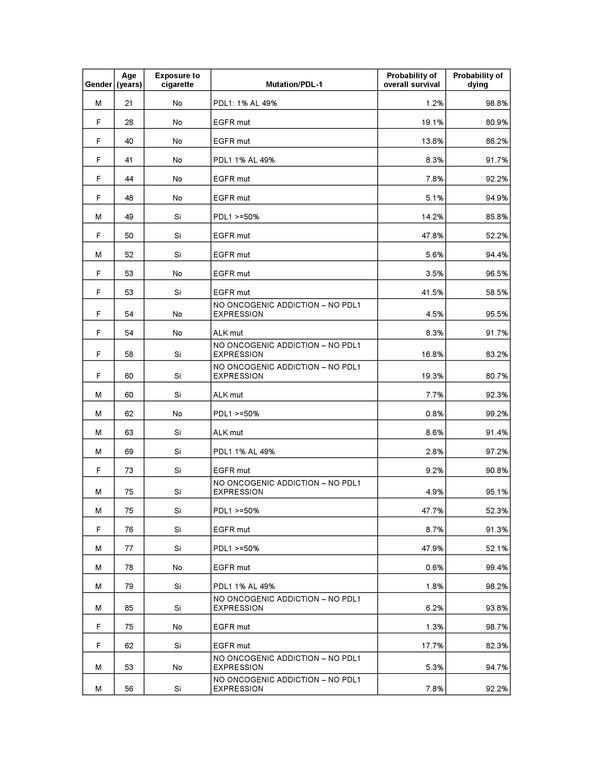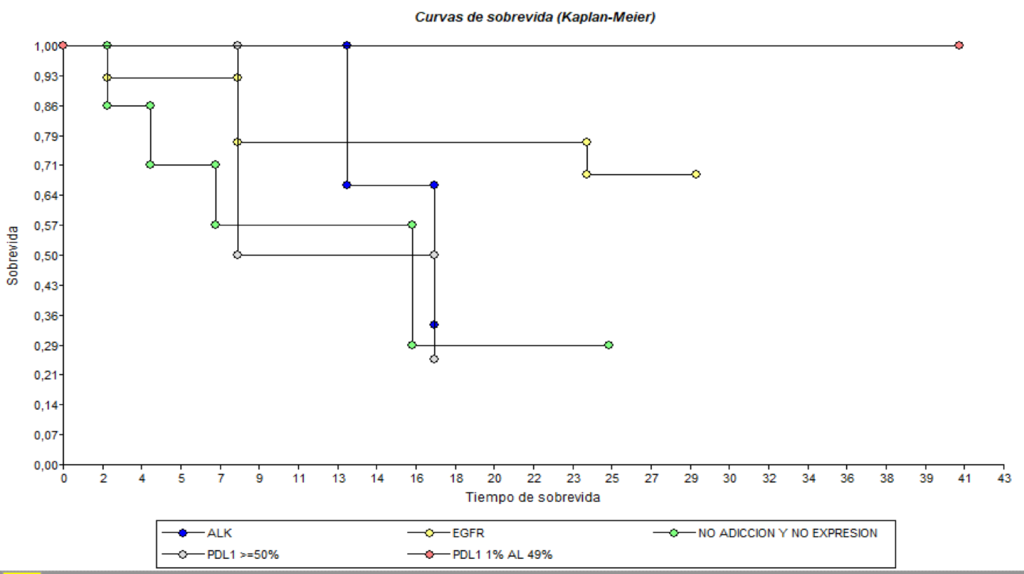Virtual Library
Start Your Search
Juan Pablo Pino
Author of
-
+
EP1.03 - Biology (ID 193)
- Event: WCLC 2019
- Type: E-Poster Viewing in the Exhibit Hall
- Track: Biology
- Presentations: 1
- Now Available
- Moderators:
- Coordinates: 9/08/2019, 08:00 - 18:00, Exhibit Hall
-
+
EP1.03-02 - Frequency of Microsatellite Instability in Patients with Primary Non Small Lung Cancer in a Single Institution from Colombia (Now Available) (ID 322)
08:00 - 18:00 | Author(s): Juan Pablo Pino
- Abstract
Background
Lung carcinogenesis is a focus of research for prognosis and development of possible therapeutic objectives. The microsatellite instability (MSI) has been described as a potential mechanism of cancer development mainly in colorectal cancer as a marker of prognosis and treatment response. In lung cancer is not known the precise frequency of MSI and its possible implications for precision therapeutics. Past trials reported a low incidence of this biological signature, but this finding could improve some immune characterization of lung cancer focused in immunotherapeutics. Is very important to know the incidence of MSI in lung cancer in a sample of latin patients to know its indicence y relation with some clinical features.
Method
The present study is a case series were we describe microsatellite instability (MSI) in patients with primary non small cell lung cancer. First, the patients with non-small cell lung carcinomas of the Hospital Militar Central diagnosed between january 2010 and january 2016 were included, then the clinical charts of each patient were reviewed to identify clinical and socio-demographic variables. The immunohistochemical staining were realized in the paraffin blocks using the Ventana Benchmark Ultra and GX equipment allowing the identification of the mismatch repair proteins (MMRP) MLH1, PMS2, MSH2 y MSH6; defining microsatellite instability with the negativity for any of these markers. We reviewed other molecular biology signatures : EGFR mutation and KRAS in some cases were this finding could be avaliable. In Colombia there´s no health system coverage for this mutations.
Result
33 patients with non-small cell lung carcinoma were included in the study. Of this patients we can identify 69.7% with lung adenocarcinoma and 30.3% with squamous cell lung carcinoma. 54.5% of the total of patients were diagnosed in stage IV (TNM 7th edition). We identified a history of tobacco exposition in 45.5% of this patients. In the immunohistochemical staining, we identify that 9.1% of all the patients had microsatellite instability (MSI high); with negativity for the expression for MHL1 gene in 2 patients and for MSH6 gene in 3 patients, all of this patients were diagnosed with lung adenocarcinoma and all of this patients were EGFR wild type, in 1 of this patients we found a registry of KRAS mutated tumor. For the MHL1-negative patients, one of them had tobacco exposition history (heavy smoker) and for the MSH6-negative patients 2 of 3 had a tobacco exposition history. Unfortunately we didn´t found any of this patients treated with immunooncology agents.
Conclusion
In a small latin population at a single institution the present study found a frequency of 9.1% in 33 patients with non-small cell lung cancer with microsatellite instability (MSI-High). All of this patients were adenocarcinoma subtype, non related with EGFR mutations and with a correlation with tobacco exposure. Unfortunately this is a small case series and we could not establish a response to immunooncology agents because in Colombia we have this medications available since 2018. The frequency of this finding is higher than previous reports and must be confirmed in a multiinstitutional registry from latin population in development.
-
+
P2.16 - Treatment in the Real World - Support, Survivorship, Systems Research (ID 187)
- Event: WCLC 2019
- Type: Poster Viewing in the Exhibit Hall
- Track: Treatment in the Real World - Support, Survivorship, Systems Research
- Presentations: 1
- Now Available
- Moderators:
- Coordinates: 9/09/2019, 10:15 - 18:15, Exhibit Hall
-
+
P2.16-22 - Predictive Analytic of Survival Using a Neural Network in a Real World Cohort of Advanced Non Small Cell Lung Cancer Patients (Now Available) (ID 2291)
10:15 - 18:15 | Author(s): Juan Pablo Pino
- Abstract
Background
When talking about a probabilistic neural network a new concept on survival is introduced. Using advanced statistics, different characteristics amongst patients such as oncogenic driver mutation, smoking status or age can be correlated to calculate the probability of survival in each individual and even for each attending institution.
Method
We built a neural network model that allowed us to estimate the probability of mortality according to the variables: Oncogenic addiction (EGFR mutation and ALK rearrangements), expression of PDL-1, age, gender and exposure to cigarette. These variables were obtained from a cohort of patients with advanced non-small cell lung carcinoma who received treatment in our institution during the last 3 years.
Result
Thirty-one patients were included in the model. The accuracy of the neural network was 78.57% for the patients that died and 82.35% for the patients still alive. It was possible to calculate the probability of overall survival and the probability of dying in relation to age, exposure to cigarette, gender, oncogenic addiction and PDL-1 expression for each person and for the whole cohort. Individual results and global results (Kaplan Meier) are shown in table and graphic.
Conclusion

The minimum data sample required to produce the model was used (n=31), thus it would not be correct to talk about global conclusions. However, this is a representative model of a proof of concept related to predictive analytics related to probability of survival in a real world setting using a neural network that worked on an individual basis according to clinical and biological characteristics. Results for the entire cohort are also available. Using a greater amount of data will increase the accuracy of the neural network to predict survival and other outcomes in an individual and even institutional basis that will improve data analytics in real oncologic settings.


